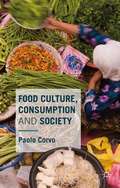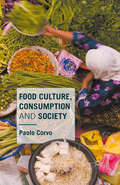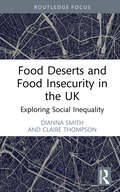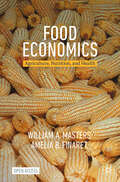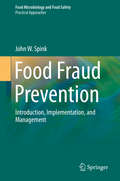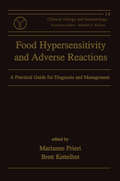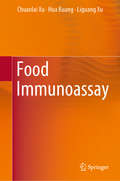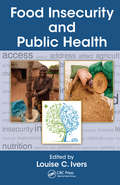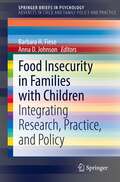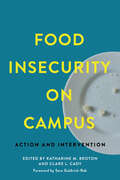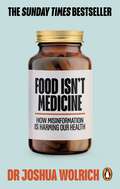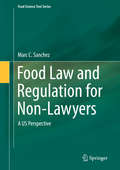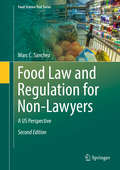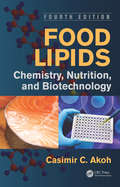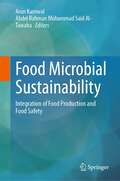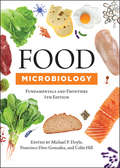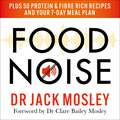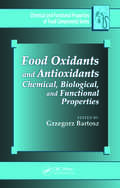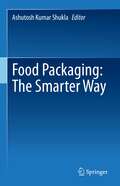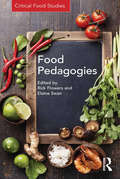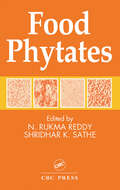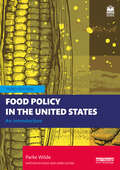- Table View
- List View
Food Culture, Consumption and Society
by Paolo CorvoThis book analyses how consumer food choices have undergone profound changes in the context of the economic crisis, including the rediscovery of local products and the diffusion of multi-ethnic food. Corvo argues that a new ecological relationship between food and the environment is needed to reduce food problems such as food waste and obesity.
Food Deserts and Food Insecurity in the UK: Exploring Social Inequality (Routledge Focus on Environment and Sustainability)
by Claire Thompson Dianna SmithThis book examines the social inequalities relating to food insecurity in the UK, as well as drawing parallels with the US. Access to food in the UK, and especially access to healthy food, is a constant source of worry for many in this wealthy country. Crises, such as the COVID-19 pandemic, have coincided with a steep rise in the cost of living, meaning household food insecurity has become a reality for many more households. This book introduces a new framework to examine the many influences on local-level food inequalities, whether they result from individual circumstances or where a person lives. The framework will allow researchers new to the field to consider the many influences on food security, and to support emerging research around different sub-topics of food access and food security. Providing a thorough background to two key concepts, food deserts and food insecurity, the book documents the transition from area-based framing of food resources, to approaches which focus on household food poverty and the rise of food banks. The book invites researchers to acknowledge and explore the ever changing range of place-based factors that shape experiences of food insecurity: from transport and employment to rural isolation and local politics. By proposing a new framework for food insecurity research and by drawing on real-world examples, this book will support academic and applied researchers as they work to understand and mitigate the impacts of food insecurity in local communities. This book will be of great interest to students and scholars of food and nutrition security, public health, and sociology. It will also appeal to food policy professionals and policymakers who are working to address social inequalities and improve access to healthy and nutritious food for all.
Food Economics: Agriculture, Nutrition, and Health (Palgrave Studies in Agricultural Economics and Food Policy)
by William A. Masters Amelia B. FinaretFood Economics provides a unified introduction to the economics of agricultural production, business decisions, consumer behavior, and the government policies that shape our food system. This open access textbook begins with economic principles derived using graphical techniques to explain and predict observed prices, quantities, and other outcomes as a result of individual choices influenced by market structure and public policies. The second half of the book explores available data globally and for the US, covering a wide range of questions in agriculture and economic development, food marketing, and consumption. Food Economics and its accompanying online resources are designed for advanced undergraduate or introductory graduate courses in agriculture, food, and nutrition policy. The book covers the standard diagrams taught in principles-level courses, with concrete examples and practical insights regarding food production, consumption, and trade. Online resources include data sources, and course materials, including slides, exercises, exams, and answer keys.
Food Fraud Prevention: Introduction, Implementation, and Management (Food Microbiology and Food Safety)
by John W. SpinkThis textbook provides both the theoretical and concrete foundations needed to fully develop, implement, and manage a Food Fraud Prevention Strategy. The scope of focus includes all types of fraud (from adulterant-substances to stolen goods to counterfeits) and all types of products (from ingredients through to finished goods at retail). There are now broad, harmonized, and thorough regulatory and standard certification requirements for the food manufacturers, suppliers, and retailers. These requirements create a need for a more focused and systematic approach to understanding the root cause, conducting vulnerability assessments, and organizing and implementing a Food Fraud Prevention Strategy. A major step in the harmonizing and sharing of best practices was the 2018 industry-wide standards and certification requirements in the Global Food Safety Initiative (GFSI) endorsed Food Safety Management Systems (e.g., BRC, FSSC, IFS, & SQF). Addressing food fraud is now NOT optional – requirements include implementing a Food Fraud Vulnerability Assessment and a Food Fraud Prevention Strategy for all types of fraud and for all products. The overall prevention strategy presented in this book begins with the basic requirements and expands through the criminology root cause analysis to the final resource-allocation decision-making based on the COSO principle of Enterprise Risk Management/ ERM. The focus on the root cause expands from detection and catching bad guys to the application of foundational criminology concepts that reduce the overall vulnerability. The concepts are integrated into a fully integrated and inter-connected management system that utilizes the Food Fraud Prevention Cycle (FFPC) that starts with a pre-filter or Food Fraud Initial Screening (FFIS). This is a comprehensive and all-encompassing textbook that takes an interdisciplinary approach to the most basic and most challenging questions of how to start, what to do, how much is enough, and how to measure success.
Food Hypersensitivity and Adverse Reactions: A Practical Guide for Diagnosis and Management
by Marianne FrieriPresents classic and recent findings on immunological dysfunctions caused by food allergies-coordinating the most advanced clinical techniques and assessment methods with practical insights for treatment and patient care.
Food Immunoassay
by Chuanlai Xu Hua Kuang Liguang XuThis book systematically covers immunoassays for food, presenting detailed approaches such as antigen design, food matrix pre-treatment and detection format optimization for 9 classes of food hazards and nutrition constituents. Offering ideas on how to improve the efficiency of recognized xenobiotics and food contents, this practical book also describes the discovery and utilization of novel immune agents like aptamer and molecular imprinted polymers in food analysis. It is intended for a broad range of areas, including biologists and food chemists, and is sure to become a key reference resource for students and professionals alike.
Food Insecurity Among Members of the Armed Forces and Their Dependents
by Beth J. Asch Thomas E. Trail Stephanie Rennane Lisa Berdie Jason M. Ward Dina Troyanker Catria Gadwah-Meaden Jonas KempfThe National Defense Authorization Act for fiscal year 2020 directed the Secretary of Defense to report on food insecurity among members of the armed forces and their dependents. RAND researchers examined the eight elements from the directive (including an assessment of the current extent of food insecurity among service members and their dependents) and developed answers, along with listing areas requiring additional analysis.
Food Insecurity and Public Health
by Louise IversAffecting more than 800 million people, food insecurity is a global problem that runs deeper than hunger and undernutrition. In addition to the obvious impact on physical well-being, food insecurity can result in risky coping strategies, increased expenditures on medical costs or transportation, and mental health issues. A review of the concepts an
Food Insecurity in Families with Children: Integrating Research, Practice, and Policy (SpringerBriefs in Psychology)
by Barbara H. Fiese Anna D. JohnsonThis book synthesizes research about the effects of food insecurity on children, families, and households, emphasizing multiple pathways and variations across developmental contexts. It focuses on emerging new methods that allow for a more refined approach to practice and policy. The volume provides a brief overview of the topic, and additional empirical chapters pose and address unanswered research questions. It concludes with a short commentary, providing recommendations for future research and policy and yielding a significant and timely contribution to advance developmental scientific knowledge and promote its use to improve the lives of children and families. Featured areas of coverage include: The effects of early food insecurity on children’s academic and socio-emotional outcomes.The effects of household food insecurity on children with disabilities.Early childhood access to Women, Infants, and. Children (WIC) and school readiness.Supplemental Nutrition Assistance Program (SNAP) and adolescent mental health. Food Insecurity in Families with Children is an essential resource for policy makers and related professionals as well as graduate students and researchers in developmental, clinical, and school psychology, child, youth and family policy, public health, and social work.
Food Insecurity on Campus: Action and Intervention
by Katharine M. Broton and Clare L. CadyThe hidden problem of student hunger on college campuses is real. Here's how colleges and universities are addressing it.As the price of college continues to rise and the incomes of most Americans stagnate, too many college students are going hungry. According to researchers, approximately half of all undergraduates are food insecure. Food Insecurity on Campus—the first book to describe the problem—meets higher education's growing demand to tackle the pressing question "How can we end student hunger?" Essays by a diverse set of authors, each working to address food insecurity in higher education, describe unique approaches to the topic. They also offer insights into the most promising strategies to combat student hunger, including• utilizing research to raise awareness and enact change; • creating campus pantries, emergency aid programs, and meal voucher initiatives to meet immediate needs;• leveraging public benefits and nonprofit partnerships to provide additional resources;• changing higher education systems and college cultures to better serve students; and• drawing on student activism and administrative clout to influence federal, state, and local policies.Arguing that practice and policy are improved when informed by research, Food Insecurity on Campus combines the power of data with detailed storytelling to illustrate current conditions. A foreword by Sara Goldrick-Rab further contextualizes the problem. Offering concrete guidance to anyone seeking to understand and support college students experiencing food insecurity, the book encourages readers to draw from the lessons learned to create a comprehensive strategy to fight student hunger.Contributors: Talia Berday-Sacks, Denise Woods-Bevly, Katharine M. Broton, Clare L. Cady, Samuel Chu, Sarah Crawford, Cara Crowley, Rashida M. Crutchfield, James Dubick, Amy Ellen Duke-Benfield, Sara Goldrick-Rab, Jordan Herrera, Nicole Hindes, Russell Lowery-Hart, Jennifer J. Maguire, Michael Rosen, Sabrina Sanders, Rachel Sumekh
Food Isn’t Medicine
by Dr Joshua Wolrich*The Sunday Times Bestseller*Does sugar cause type 2 diabetes?Are vegan diets always healthier?Is weight the main driver of our health?No, no and absolutely not - NHS doctor and nutritionist Joshua Wolrich is on a mission to set the record straight.In Food Isn't Medicine, he draws on the latest nutritional science to cut through what he calls 'nutribollocks', unravelling the false beliefs that too often inform how we eat. With candour and compassion, he debunks damaging food myths and dismantles the most pervasive of them all: the myth that your weight defines your health.If you have ever considered intermittent fasting, avoided artificial sweeteners, dairy or carbs for 'health' reasons, or struggled through diet after diet wondering why nothing seems to work, this book will be a powerful wake-up call.'Excellent - I couldn't put it down' Jameela Jamil'A beacon of truth in a sea of misinformation' Alice Liveing'Joshua brings a much-needed dose of reality - calling out the nonsense, helping you steer away from the empty promises of fad diets and giving you the tools to once again have a healthy relationship with food, your body and life' Dr Tim Crowe
Food Law and Regulation for Non-Lawyers
by Marc C. SanchezThe book offers a succinct overview of key topics and core concepts for food scientists, quality managers, and others who need to understand the regulation of food and dietary supplements in the U. S. It was designed and modeled after a six-week introduction to food law course currently taught at Northeastern University, and serves as a practical tool for regulatory professionals. The book includes a chapter on each major topic, with summations of the legislative history and general legal landscape. Each chapter focuses the reader on major and emerging issues encountered by facilities. A comparative law section at the end of every chapter offers readers an ability to view alternative methods of regulation and enforcement. This design is unique and allows students and working professionals alike to understand core concepts and the practical application of the law to their work. Using a modified casebook method approach, the book also serves as a practical tool for regulatory professionals.
Food Law and Regulation for Non-Lawyers: A Us Perspective (Food Science Text Ser.)
by Marc C. SanchezDesigned and modeled after a six-week introductory food law course taught at Northeastern University, Food Law and Regulation for Non-Lawyers offers a succinct overview of key topics and core concepts for food scientists, quality managers, and others who need to understand the regulation of food in the U.S. This second edition includes critical updates on the Food Safety Modernization Act-- the first change to the food safety laws in over 70 years. The seven foundational rules, finalized in 2015, are discussed in detail. The new edition also includes other regulatory updates such as the new Nutrition Fact Panel, changes to the definition of fiber, and the FDA’s attempt to regulate the widely used “healthy” claim. These timely updates, along with the core concepts of the first edition, make the volume an essential and practical tool for regulatory professionals.
Food Lipids: Chemistry, Nutrition, and Biotechnology, Fourth Edition
by Casimir C. AkohMaintaining the high standards that made the previous editions such well-respected and widely used references, Food Lipids: Chemistry, Nutrition, and Biotechnology, Fourth Edition provides a new look at lipid oxidation and highlights recent findings and research. Always representative of the current state of lipid science, this edition provides 16 new chapters and 21 updated chapters, written by leading international experts, that reflect the latest advances in technology and studies of food lipids.New chapters Analysis of Fatty Acid Positional Distribution in Triacylglycerol Physical Characterization of Fats and Oils Processing and Modification Technologies for Edible Oils and Fats Crystallization Behavior of Fats: Effect of Processing Conditions Enzymatic Purification and Enrichment and Purification of Polyunsaturated Fatty Acids and Conjugated Linoleic Acid Isomers Microbial Lipid Production Food Applications of Lipids Encapsulation Technologies for Lipids Rethinking Lipid Oxidation Digestion, Absorption and Metabolism of Lipids Omega-3 Polyunsaturated Fatty Acids and Health Brain Lipids in Health and Disease Biotechnologically Enriched Cereals with PUFAs in Ruminant and Chicken Nutrition Enzyme-Catalyzed Production of Lipid Based Esters for the Food Industry: Emerging Process and Technology Production of Edible Oils Through Metabolic Engineering Genetically Engineered Cereals for Production of Polyunsaturated Fatty Acids The most comprehensive and relevant treatment of food lipids available, this book highlights the role of dietary fats in foods, human health, and disease. Divided into five parts, it begins with the chemistry and properties of food lipids covering nomenclature and classification, extraction and analysis, and chemistry and function. Part II addresses processing and food applications including modification technologies, microbial production of lipids, crystallization behavior, chemical interesterification, purification, and encapsulation technologies. The third part covers oxidation, measurements, and antioxidants. Part IV explores the myriad interactions of lipids in nutrition and health with information on heart disease, obesity, and cancer, with a new chapter dedicated to brain lipids. Part V continues with contributions on biotechnology and biochemistry including a chapter on the metabolic engineering of edible oils.
Food Microbial Sustainability: Integration of Food Production and Food Safety
by Arun Karnwal Abdel Rahman Mohammad Said Al-TawahaThis book reviews all important aspects of Microbial sustainability in food production and food safety with the aim of shedding new light on these microbes through combined understanding of traditional and novel paradigms. The book is divided into three sections, the first of which reinterprets fundamentals of food microbiology, examining the beneficial aspects of microorganisms in food and microbial responses from food environments and preservation. The second section discusses recent advances in understanding of the sustainable food production, covering, for example, agriculturally important microbes, farming microbes, and fermentation. A wide range of bio-factory issues in food production are also addressed, before turning attention to contemporary food safety approaches in the context of novel assessment methods for microbiological food characterization, improving food safety and food quality, etc. The final section is devoted to public health and its importance of microorganisms in food processing as well as the economic importance of microorganisms as this is also an increasingly important area as we move toward microbial research advances.
Food Microbiology: Fundamentals and Frontiers (ASM Books)
by Colin Hill Michael P. Doyle Francisco Diez-GonzalezSince its introduction in 1997, the purpose of Food Microbiology: Fundamentals and Frontiers has been to serve as an advanced reference that explores the breadth and depth of food microbiology. Thoroughly updated, the new Fifth Edition adds coverage of the ever-expanding tool chest of new and extraordinary molecular methods to address many of the roles that microorganisms play in the production, preservation, and safety of foods. Sections in this valuable reference cover material of special significance to food microbiology such as: stress response mechanisms, spores, and the use of microbiological criteria and indicator organisms commodity-oriented discussion of types of microbial food spoilage and approaches for their control the major foodborne pathogens, including diseases, virulence mechanisms, control measures, and up-to-date details on molecular biology techniques state-of-the-science information on food preservation approaches, including natural antimicrobials and the use of bacteriophages in controlling foodborne pathogens beneficial microbes used in food fermentations and to promote human and animal health updated chapters on current topics such as antimicrobial resistance, predictive microbiology, and risk assessment This respected reference provides up-to-the-minute scientific and technical insights into food production and safety, readily available in one convenient source.
Food Noise: How weight loss medications & smart nutrition can silence your cravings
by Dr Jack Mosley'GLP-1s, miracle or menace? Everyone should read this great book' Tim Spector'This is a superb book for anyone who is considering taking (or talking about) the new weight loss drugs - in other words all of us' Chris Van TullekenDr Jack Mosley's groundbreaking book is your complete trusted guide to the new weight-loss revolution.Constant, unwanted thoughts about food - Food Noise - can be impossible to silence in our world of compelling marketing messages and ongoing temptation.GLP-1s (Ozempic, Wegovy, Mounjaro et al) are said to be the biggest medical breakthrough in decades. They banish food cravings, subsequent weight loss is rapid, and the drugs are said to bring many additional health benefits, but one question remains; how do you lose the weight well, and sustain it for life?The author weighs up the pros and cons of these so-called "miracle" drugs, and, building on the legacy of his father Dr Michael Mosley, he combines medical insight from leading experts, with practical advice, and real-life stories from those who have experienced both the highs and the lows of GLP-1 drugs. Critically, he answers the questions few are addressing: Are you losing fat or muscle? How can you meet your body's nutritional needs? And how can you embrace a lifestyle that nourishes both body and mindThis book will help you:Understand the Science: Dr Jack Mosley explains how these drugs work and asks 'are they a game-changer or a health hazard?'.Transform Your Diet: Learn how to eat well when your appetite is reduced, with 50 delicious recipes and a 7-day meal plan, supplied as a PDF with your audiobook. Sustain the Change: Discover how to maintain your weight loss after stopping the medication and build long lasting, healthy habits. Whether you're considering these medications, already taking them, or simply curious about weight loss methods, this is the ultimate resource to reclaim your health and reshape your life.*The reported issues with this recording are now resolved. If you downloaded it previously please delete and redownload to your device now to listen to the corrected audiobook.*
Food Noise: How weight loss medications & smart nutrition can silence your cravings
by Dr Jack Mosley'GLP-1s, miracle or menace? Everyone should read this great book' Tim Spector'This is a superb book for anyone who is considering taking (or talking about) the new weight loss drugs - in other words all of us' Chris Van TullekenDr Jack Mosley's groundbreaking book is your complete trusted guide to the new weight-loss revolution.Constant, unwanted thoughts about food - Food Noise - can be impossible to silence in our world of compelling marketing messages and ongoing temptation.GLP-1s (Ozempic, Wegovy, Mounjaro et al) are said to be the biggest medical breakthrough in decades. They banish food cravings, subsequent weight loss is rapid, and the drugs are said to bring many additional health benefits, but one question remains; how do you lose the weight well, and sustain it for life?The author weighs up the pros and cons of these so-called "miracle" drugs, and, building on the legacy of his father Dr Michael Mosley, he combines medical insight from leading experts, with practical advice, and real-life stories from those who have experienced both the highs and the lows of GLP-1 drugs. Critically, he answers the questions few are addressing: Are you losing fat or muscle? How can you meet your body's nutritional needs? And how can you embrace a lifestyle that nourishes both body and mindThis book will help you:Understand the Science: Dr Jack Mosley explains how these drugs work and asks 'are they a game-changer or a health hazard?'.Transform Your Diet: Learn how to eat well when your appetite is reduced, with 50 delicious recipes and a 7-day meal plan. Sustain the Change: Discover how to maintain your weight loss after stopping the medication and build long lasting, healthy habits. Whether you're considering these medications, already taking them, or simply curious about weight loss methods, this is the ultimate resource to reclaim your health and reshape your life.
Food Noise: How weight loss medications & smart nutrition can silence your cravings
by Dr Jack Mosley'GLP-1s, miracle or menace? Everyone should read this great book' Tim Spector'This is a superb book for anyone who is considering taking (or talking about) the new weight loss drugs - in other words all of us' Chris Van TullekenDr Jack Mosley's groundbreaking book is your complete trusted guide to the new weight-loss revolution.Constant, unwanted thoughts about food - Food Noise - can be impossible to silence in our world of compelling marketing messages and ongoing temptation.GLP-1s (Ozempic, Wegovy, Mounjaro et al) are said to be the biggest medical breakthrough in decades. They banish food cravings, subsequent weight loss is rapid, and the drugs are said to bring many additional health benefits, but one question remains; how do you lose the weight well, and sustain it for life?The author weighs up the pros and cons of these so-called "miracle" drugs, and, building on the legacy of his father Dr Michael Mosley, he combines medical insight from leading experts, with practical advice, and real-life stories from those who have experienced both the highs and the lows of GLP-1 drugs. Critically, he answers the questions few are addressing: Are you losing fat or muscle? How can you meet your body's nutritional needs? And how can you embrace a lifestyle that nourishes both body and mindThis book will help you:Understand the Science: Dr Jack Mosley explains how these drugs work and asks 'are they a game-changer or a health hazard?'.Transform Your Diet: Learn how to eat well when your appetite is reduced, with 50 delicious recipes and a 7-day meal plan. Sustain the Change: Discover how to maintain your weight loss after stopping the medication and build long lasting, healthy habits. Whether you're considering these medications, already taking them, or simply curious about weight loss methods, this is the ultimate resource to reclaim your health and reshape your life.
Food Oxidants and Antioxidants: Chemical, Biological, and Functional Properties (Chemical & Functional Properties of Food Components)
by Grzegorz BartoszFood antioxidants are of primary importance for the preservation of food quality during processing and storage. However, the status of food depends on a balance of antioxidants and prooxidants occurring in food. Food Oxidants and Antioxidants: Chemical, Biological, and Functional Properties provides a single-volume reference on the effects of natur
Food Packaging: The Smarter Way
by Ashutosh Kumar ShuklaThis book reviews the science and technology of food packaging and covers the potential innovations in the food packaging sector. At the same time, it highlights the issues and prospects for linking the laboratory research to the market. In addition to typical packaging requirements such as food quality, shelf life, protection, communication, and marketing, the book emphasizes the need for novel packaging materials, including biodegradable packaging for a variety of food products. A wide range of food products has been kept in focus and includes animal-based food products such as dairy products and sea foods. The book presents the next level of packaging solutions i.e., smart packaging with the applications of potential tools such as intelligent and active packaging, and includes the latest research on emerging digital technologies for packaging development, assessment, and acceptability. It further highlights the strategies including blends, reinforcing agents, cold plasma, UV light applications, chemical, and enzymatic methods and explores the new opportunities leading to improvement in the packaging performance. Smart freshness indicator applications, including gas and time-temperature indicators for quality and safety of packaged products, have been covered in detail. The book also includes the functional characteristics of edible films and coatings, including their bioactive characteristics. Finally the book presents the rules and regulation related to packaging.
Food Pedagogies (Critical Food Studies)
by Elaine Swan Rick FlowersIn recent years everyone from politicians to celebrity chefs has been proselytizing about how we should grow, buy, prepare, present, cook, taste, eat and dispose of food. In light of this, contributors to this book argue that food has become the target of intensified pedagogical activity across a range of domains, including schools, supermarkets, families, advertising and TV media. Illustrated with a range of empirical studies, this edited and interdisciplinary volume - the first book on food pedagogies - develops innovative and theoretical perspectives to problematize the practices of teaching and learning about food. While many different pedagogues - policy makers, churches, activists, health educators, schools, tourist agencies, chefs - think we do not know enough about food and what to do with it, the aims, effects and politics of these pedagogies has been much less studied. Drawing on a range of international studies, diverse contexts, genres and different methods, this book provides new sites of investigation and lines of inquiry. As a result of its broad ranging critical evaluation of ’food as classroom’ and ’food as teacher’, it provides theoretical resources for opening up the concept of pedagogy, and assessing the moralities and politics of teaching and learning about food in the classroom and beyond.
Food Phytates
by N. Rukma Reddy Shridhar K. SatheFood Phytates takes a new look at phytates, including their potential health benefits. It includes the latest information on the beneficial heath effects of phytates, the influence of phytates in disease prevention, the potential use of phytate as an antioxidant in foods, and phytase expression in transgenic plants. In 14 chapters, leading research
Food Policy in the United States: An Introduction (Earthscan Food and Agriculture)
by Parke WildeThis third edition of Food Policy in the United States offers a timely update to the leading textbook dedicated to all aspects of food policy in the United States.This book begins with the economic interests of farmers and food producers and then moves on to examine nutrition policy, food justice, food security, and the environment. Finding motivation in real-world controversies and debates, chapters cover domestic agriculture, international agricultural trade, food and beverage manufacturing, food retail and restaurants, food safety, dietary guidance, food labeling, advertising, and federal food assistance programs for the poor. Building on the success of the second edition, which received the Distinguished Quality of Communication award from the Agricultural and Applied Economics Association (AAEA), this new edition has been revised and updated, offering greater attention both to food justice issues, and to economic methods. It covers policy changes since the 2018 Farm Bill, the publication of the 2020–2025 Dietary Guidelines for Americans, the 2021 update to the "Thrifty Food Plan", and President Donald Trump's approach to food and agricultural trade. The impact of COVID-19 and the continuing climate crisis are examined, alongside stalled child nutrition reauthorization legislation, reforms in food-labeling, and immigration policy. The online Instructor and Student Resources include supplemental economic appendices, problem sets, activities, and exercises: www.routledge.com/cw/Wilde. This book makes U.S. food policy more comprehensible to those inside and outside the agri-food sector whose interests and aspirations have been ignored.This book is essential reading for all students, researchers, and policymakers seeking to understand U.S. food policy from a wide range of interdisciplinary backgrounds, including food studies, agricultural and food economics and policy, public health and nutrition, and public policy.
